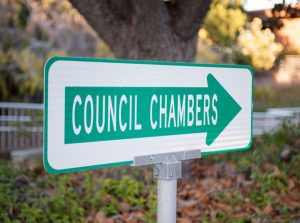In the national conversation about reforming local police agencies, a central topic is the role played by law enforcement unions in blocking reform and diverting resources to ever-growing police department budgets.
Four years ago, Santa Clara’s developer-funded police union PAC became the biggest single spender in City politics, increasing its political spending by 2,500 percent between 2014 and 2016.
This isn’t an aberration. Across the country police unions spend millions to influence elections to maintain immunity from accountability and big police budgets.
Since 2015, currently serving U.S. public officials have benefitted from nearly $15 million in police union political spending, according to the NoMoreCopMoney database — about two thirds of it to Democratic elected officials. In California since 2015, politicians received $6.3 million in donations from police PACs.
For a city its size, Santa Clara plays in the big leagues when it comes to police PAC spending.
From 2016 through 2018, San Francisco Police Officer Association (POA) PACs spent about $750,000 on campaign donations and independent expenditures. Oakland’s police PAC spent about $80,000. The LA Times recently documented LA’s Police Protection League’s nearly $2 million in political spending in the last few years.
Over the same time period Santa Clara’s POA PAC spent about $150,000 on independent expenditures in City campaigns — about $0.85 per resident. In contrast, Sunnyvale’s Public Safety union PAC has spent about $40,000 in campaign donations and independent expenditures — about $0.30 per resident.
Police union political spending often — but not always — correlates to outsize police budgets.
Out of Los Angeles’ $10.5 billion general fund, the police department receives $3.14 billion. San José PD receives $447 million of the city’s $1.5 billion general fund. Oakland’s PD receives over 40 percent of that city’s $665 million unrestricted spending budget.
San Francisco spends a smaller proportion of its $6.2 billion general fund on police: $606 million.
Santa Clara’s police department receives slightly less than a third of the City’s $269 million general fund budget — $77 million.
In Santa Clara, Election Years are Union Contract Years, And Everybody Wins
In 2016 the Santa Clara POA PAC debuted its campaign financing model: taking large donations from developers and using the money for expensive independent expenditure campaigns against the opposing candidates.
That year, it funneled developer money to Mayor Lisa Gillmor’s Council allies and incumbents — Council Members Debi Davis, Teresa O’Neill and Kathy Watanabe — and Gillmor’s political allies Council candidate Tino Silva, and police chief candidate and former union president Patrick Nikolai.
So far this is a win-win for everyone.
The police union’s candidates benefited from unlimited special interest spending; effectively making campaign spending limits irrelevant for themselves while enforcing spending limits on their opponents.
While direct donations are subject to federal, state and local campaign finance laws, the Citizens United Supreme Court decision exempted independent expenditure committees from any limits.
It also allowed the union’s candidates to publicly proclaim that they don’t take any special interest money and maintain “plausible deniability” when confronted by what looked to some like an anti-immigrant dog whistle in the black/white 2016 “Letter From Your Mayor” mailers.
Developers benefited by hiding behind a group with much higher public approval — police officers — and concealing their outsize financial influence from the vast majority of people who don’t have time to track down the crumb trail of campaign donors.
And finally, the police union didn’t have to spend their own money — instead using developer money — while ensuring another round of generous contract negotiations.
The police contract — Memorandum of Understanding, MOU — for 2016-17 offered a 5 percent increase for the first year and a 3 percent raise the second.
The 2018-2021 contract offered the same 5 percent increase for the 2018. Upcoming increases will be percentages “needed to place a Santa Clara Police Officer at 5.5% above the total compensation average for the survey agencies as of January 1, 2020… and 6% above the …average for the survey agencies as of January 1, 2021.”
The results aren’t hard to find.
In 2015, not one of Santa Clara’s base police salaries made the top 25 police officer base salaries in California. In 2016, Santa Clara only accounted for four of the top 25 base police officer salaries.
After 2016, the picture changed. In 2017, Santa Clara had 21 of the top 25 base salaries. In 2018, 19 of the top 25 and 17 in 2019. (TransparentCalifornia.com)
Finally, it’s no surprise that the police PAC brought its financial heft to bear in City Hall’s effort to restore at-large elections (Measure C) after Santa Clara lost a voting rights lawsuit, conducting a push poll that the union never reported as a campaign expenditure.
The election of two outsider candidates to City Council seats in 2018 despite massive police union spending, made it clear that the union — and its developer financiers — couldn’t count on having the same biddable Council to negotiate with in a by-district system.
So far this year the POA PAC has reported $35,000 in donations from union members, but no outside donations. But the campaign is only starting.
Santa Clara POA President Alex Tork didn’t respond to The Weekly’s request for comment.
Sources: Political spending data comes from campaign finance reports, unless otherwise noted.
Corrected: “The LA Times recently documented LA’s Police Protection League’s nearly $2 million in political spending in the last few years.” previously said $2 billion.












0 comments